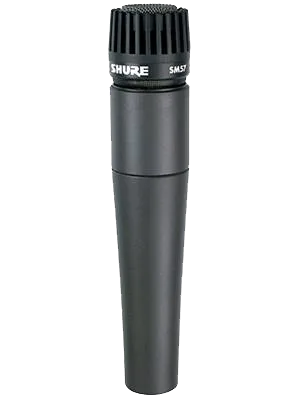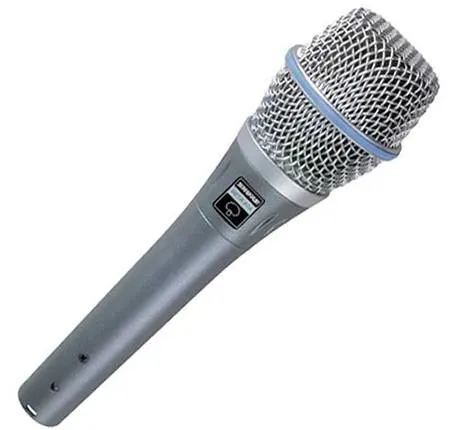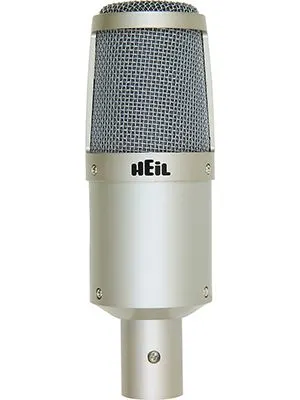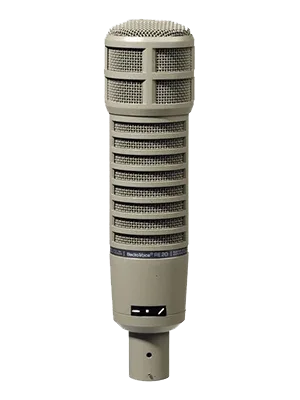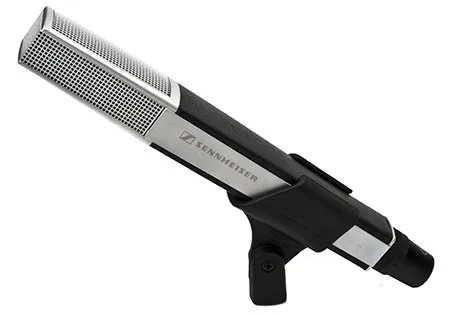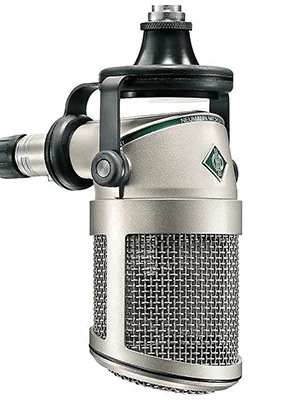The best dynamic microphone for vocals or any other recording application can’t be determined by price or opinion. Sometimes we need a cheap option when constrained by budget and need to look at which shine for our particular sound source. At other times, money isn’t a problem. But when you get to the top range they can all be deemed the best and it depends on which flavor of “best” you prefer…
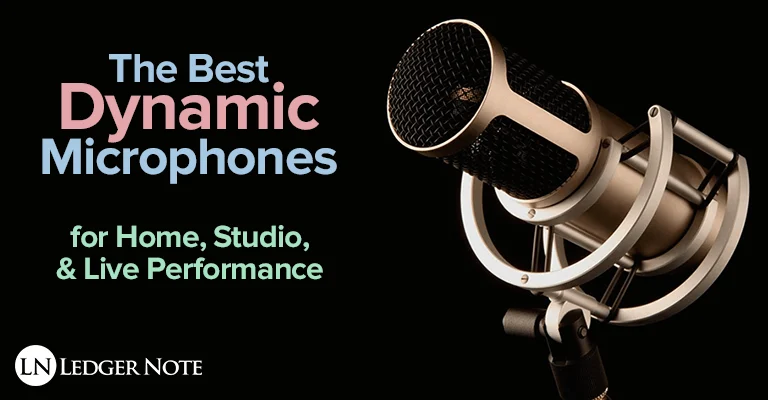
Our goal here then is to have a quick discussion about the best dynamic microphones (as opposed to condensers) and what else is needed to use them and care for them. It applies to lesser ones as well, though I hope you don’t settle for one of those.
If you already know you want a dynamic then you may already know some of this preliminary info and can skip to our reviews using the link just above.
In this article, we’ll look at the best option for dynamics in each price range, discussing the details of each mic and how they perform on various sources. We have also reserved a space in our FAQ section to discuss the basics, key specs and things to look out for when purchasing a new mic.
Need more information in order to better understand your needs? We have got you covered! Visit our FAQs section.
INCLUDED IN THIS GUIDE:
| SHURE SM57 / 58 | Best Budget Pick | Buy on Amazon |
| SHURE BETA 87A | Best Hybrid Mic | Buy on Amazon |
| HEIL SOUND PR 30 | Best for Low Noise and Transparent Output | Buy on Amazon |
| SHURE SM7B | Best Bang for the Buck | Buy on Amazon |
| ELECTRO-VOICE RE-20 | Best of the Best | Buy on Amazon |
| SENNHEISER MD 441-U | Bes for Vocals and Instruments Alike | Buy on Amazon |
| NEUMANN BCM 705 | Best for Professionals | Buy on Amazon |
The Best Cheap Dynamic Microphone
These are not remotely the “bottom rung” in terms of price. You can head down to your local RadioShack and scoop up a condenser for $10 or you can save the time and flush your money down the toilet.
These are as low as you should go if you are serious about achieving high quality as a hobbyist or professional. The first recommendation is the cheapest and world-class…
SHURE SM57 / 58
If you’re absolutely strapped for cash but still need to get the best results possible, this is what you want.
The Shure SM57 and SM58 mics are the same minus the way they look on the top. They’re known as the “Industry Workhorse” because of two aspects… They can capture any sound source faithfully and seem to have no limitation to how good they can get.
What I mean is, even though they are the cheapest on this list, they can hang with even the big boys as you start to run them through better preamplifiers and other gear.
Every pro studio has at least one of these if not a dozen. More often than not when watching live bands play, you’ll see a handful of these on stage. You’ve heard them on countless major label and indy releases.
They appear everywhere and are good for everything. And not that you should treat them roughly but they can take a crazy beating too.
What’s great is that you can save some cash with this mic and invest it in other gear. As you make the rounds, you’ll find the mic improves and performs better too. I have no clue where the ceiling of improvement is…
I’ve pumped mine through expensive interfaces and preamps that cost more than my car and it kept getting better. These stay with you for life.
Specs:
- Item Weight: 0.7 pounds
- Connector Type: XLR
- Polar Pattern: Unidirectional
Pros:
- Great value for the performance
- Easy to use and solid build quality
Cons:
- Not really ideal for vocals
Best Dynamic Mics Under $300
As we jump up an increment in price, your expectations should as well. You won’t be disappointed. While the recommendation above grows with the rest of the gear you surround it with, these will provide an immediate and noticeable improvement no matter what you’re running them through.
SHURE BETA 87A
The Shure Beta 87A is an interesting hybrid. It’s a condenser built like a dynamic and performs like one enough that I felt fine including it here. Although you can use this on other sources just fine, it was built to excel at one thing… vocals.
This baby features a supercardioid pickup pattern to narrow down the pickup range even tighter than cardioid patterns that are used on most other mics. This keeps the noise out and let’s you take advantage of the proximity effect to get those rich, creamy vocals.
Sometimes this means having boomy vocals with too much bass, so the mic also features an optional low-frequency roll-off switch to equalize out the sub-bass without effecting the sound of your voice.
Another nice addition is the pop filter built inside the capsule on top, which helps in live performances when you can’t have one goose-necked off of your mic stand. In terms of the frequency response characteristics, this mic exhibits a slight boost in the 3 kHz to 6 kHz “presence” range.
Most mixers add this across the board, so it’s nice that it’s already there. It adds a sense of intelligibility to your lyrics and helps you command your space in the stereo field.
I consider this a great choice for the price range, especially for vocals and close miking any other source.
Specs:
- Item Weight: 0.5 pounds
- Connector Type: XLR
- Polar Pattern: Supercardioid
Pros:
- Offers balanced frequency response
- Great noise reduction
- Great for all types of voices and singing styles
Cons:
- Highs can be a bit brittle
HEIL SOUND PR 30
The Heil Sound PR 30 has an extremely flat frequency response with a slight bump in the presence range like the Beta 87A above. If you’re looking for a largely transparent mic that outputs exactly what it hears without adding much flavor than definitely consider this option.
One of the things this mic is known for is its hum bucking coil combined with its low-mass diaphragm. This helps it resist hiss and hum from other electronic equipment in the vicinity, meaning a very quiet noise floor! Its screen was built with vocals in mind to act as a wind screen and pop filter but also shines on guitars, electric or acoustic.
That’s all there is to say! She’s quiet and transparent. This will become even more noticeable as you control your recording room’s environment as time goes on. It’s a good buy for sure.
Specs:
- Item Weight: 1.2 pounds
- Connector Type: XLR
- Polar Pattern: Unidirectional
Pros:
- Provides extremely warm and intimate sound
- Easy to use and great sound quality
Cons:
- The mic jack can be a bit tight
Best Dynamic Vocal Mic Under $500
Here we step into the realm of absolute perfection. These two options are a couple of the most used and famous mics around. One of them is my favorite dynamic mic of all time and you’ll see why… Let’s start with the most famous:
SHURE SM7B
Oh lordy. The Shure SM7B was always respected as a high quality mic. Heck, it’s the 3rd Shure on the list. Shure doesn’t mess around when it comes to dynamics and this was realized globally when Michael Jackson’s Thriller record became the best seller of all time.
Bruce Swedien and Quincy Jones used this as the main vocal mic on Thriller and it was used on many of his M.J.’s hits after that too. If it’s good enough for the best pop star of all time then…
It combines all of the best features you could hope for. Its frequency response is extremely flat minus the Shure presence boost you’d add anyways. It also features a low-frequency roll-off so you can block out sub-bass noises from ever entering your tracks in the first place.
Not only can you shock mount the mic but it has a built in shock mount inside for double the isolation. You can see in the image above the included wind screen and pop filter. This baby was built for vocals. You can literally conquer the music industry with this mic. The Thriller teamed proved it. And it’s not even that expensive!
Specs:
- Item Weight: 2.03 pounds
- Connector Type: XLR
- Polar Pattern: Unidirectional
Pros:
- Great build and classy aesthetics
- Smooth and warm for speech and vocals
Cons:
- A bit expensive
- Limited polar pattern
ELECTRO-VOICE RE-20
The Electro-Voice RE-20 is my favorite dynamic mic of all time. While the SM7B above is known for its huge impact on M.J.’s Thriller, you’d never guess that the world has heard this mic far more many times.
This is the preferred mic of all broadcast stations and radio DJ’s around the globe. The reason is that it features an insane proximity effect. The closer you get to it, the more dominance, confidence, and “oomph” your voice will sound. This is precisely what’s responsible for that “radio announcer sound” that you hear on every station.
I like it for all vocals but especially for recording rappers. The small voiced guys sound huge. The huge voiced guys sound like the voice of God. It’s incredible.
Electro-Voice themselves say it has a minimal proximity effect but then say it has a “voice tailored frequency response.” Tack in the bass roll-off switch and that combination comes together to create vocal heaven.
I recommend it for all male vocals and females who sing in the lower registers like Karen Carpenter. Also, anyone on the radio or recording podcasts needs to get this without hesitation.
Specs:
- Item Weight: 1pound
- Connector Type: XLR
- Polar Pattern: Unidirectional
Pros:
- Versatile and excellent sound
Cons:
- A bit pricey
Best Dynamic Microphone For Vocals – No Cost Restrictions
Now we’re in the realm of “Cost doesn’t matter, just show me the goods!” My opinion is that the two options above are more than good enough. They are two of the best ever.
These two below might just barely edge them out, but at a point of diminishing returns. It really depends on how much post-processing you plan on doing.
These are for the folks out there that want to rest easy knowing they didn’t short-change themselves.
SENNHEISER MD 441-U
People consider the Sennheiser MD 441-U the most accurate dynamic out there. They mean that the frequency response is the flattest possible so that the mic itself neither adds nor subtracts anything from the sound source. This consequentially makes it the most versatile dynamic mic available as well.
Despite the open cage on top, it rejects bleed from other sources in the room or on stage very well thanks to it’s hypercardioid pickup pattern. Apparently this is Stevie Nicks’ and Tom Petty’s preferred vocal mic. I can’t argue with that!
To reel off some features, there’s a built-in pop filter, hum compensation coil, internal shock mount, a five-position bass roll-off switch, and a treble boost switch. These switches let you contour your sound however you like for any sound or instrument, but most people say to just keep them all off and let the mic do its job naturally.
Even ignoring the rest of these details, this mic looks incredible and would make a great way to “wow” clients or to use when you know there’s going to be a camera around.
Specs:
- Item Weight: 2.05 pounds
- Connector Type: XLR
- Polar Pattern: Unidirectional
Pros:
- Accurate and versatile dynamic mic available
Cons:
- Expensive price point
- Not recommended for beginners
NEUMANN BCM 705
Even non-musicians have usually heard of Neumann. The Neumann BCM 705 continues the legacy as their first dynamic option ever. It looks awesome, but the look of it is just part of it’s several layers of isolation from mechanical noises traveling up the mic stand or when bumped.
Like the Electro-Voice RE-20 above, it features a nice proximity effect tweaked to perfection by a low-frequency roll-off switch and a slight presence boost. This helps tremendously for vocal intelligibility which explains why those in the broadcast world love this mic and the RE-20.
Because it’s designed to have people’s faces right up to it all day every day, it comes with a built in pop filter and wind screen. The front headgrille can be removed for cleaning as well so you always maintain a professional presentation.
There’s not much more you can say about Neumann. It’s one of those “you have to hear it” deals, because they are truly a cut above.
Specs:
- Item Weight: 1.8 pounds
- Connector Type: XLR
- Polar Pattern: Unidirectional
Pros:
- Has a dynamic directional characteristic
- Great build quality and excellent audio quality
Cons:
- Not recommended for beginners
FAQs
In this section, we’ll cover exactly what makes a microphone a dynamic mic, other items needed to achieve the highest quality results possible, and share some other content you can explore your mixes
What is a Dynamic Microphone?
The best way to explain what a dynamic mic is to compare it to its equally popular brother, the condenser mic. The key differences lie in how the diaphragm helps produce the electrical signal that carries your audio and its physical orientation within the structure of the mic body.
There are two ways that a diaphragm, which is a thin sheet that reacts to the pressure of sound waves coming at it, can generate our audio signal. The first is how dynamics do it.
What happens here is as sound bounces against the diaphragm, it vibrates it and causes it to pass a magnet across winded coil. When this occurs, the direction and distance of the magnetic field causes electrons to flow through the coil and down your mic cable.
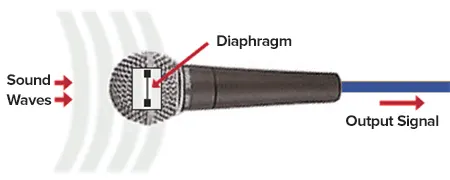
Now, the way condenser mics do it is through the use of a constantly charged capacitor. A capacitor can store an electrical charge and then discharge it based on the distance of two plates across from each other.
So as the diaphragm is pushed by the sound waves it moves along with the plate attached to it towards the other stationary plate. This produces the audio signal and moves it along the cable.
Due to these two types of construction dynamics usually, but not always, have certain features associated with them:
- Withstanding higher sound pressure levels (SPL)
- Less sensitive to details in the higher frequencies
- Sturdier construction that resists breaking
Condenser diaphragms and their vacuum tubes are more susceptible to problems related to mic stands being knocked over. Dynamics can take it like a champ because of the orientation of the diaphragm, the capacitor, and the lack of a tube. This is why you almost always see them in live performance scenarios.
They also tend to do well with close miking because of their higher SPL capacities and that they aren’t so sensitive as to pick up every single little noise in the environment. They tend to not need as much isolation to produce a quiet and pure signal.
None of this means that dynamics can’t perform as well or better than condensers.
It’s the bonuses that come along with their construction.
What Is Needed To Record With a Dynamic Mic?
Nothing is more disappointing than scoring your first mic and realizing you didn’t know as much as you thought or that someone misinformed you. This sounds like a lot but there is an easy solution so don’t worry but do read it! You need to know this stuff.
You can’t just buy a mic and an XLR cable and start recording!
Let’s start at the beginning of the signal path and explain the bare minimum needed to end up with a useable recording on your computer.
Acoustic Treatment: An optional consideration is your acoustic environment if recording in a home studio. Your vocals or guitar will have sound waves bouncing off all of your walls and back into the mic, giving you less than crisp result.
You can minimize it by moving closer to the mic but nothing brings life changing results like acoustic treatment or a good reflection panel, which is like a mini-booth just for your mic.
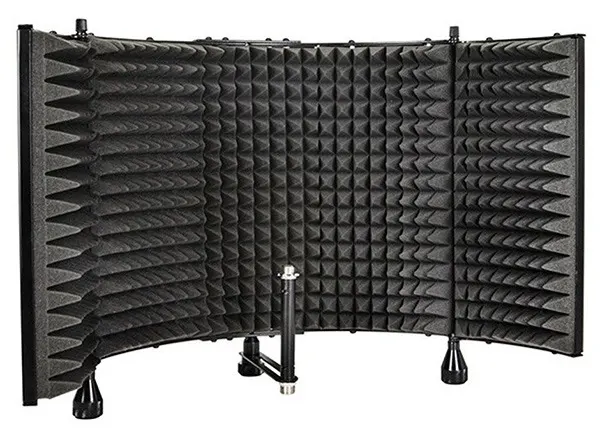
Preamplifier: Every mic on the planet produces what’s called a mic-level signal. It’s real quiet. If you run your mic straight into your computer’s sound card and then turn up the volume in your software, you’ll also be turning up the noise floor.
This means your result will have hum, hiss, and all kinds of other extremely quiet electrical and environmental sounds will be exposed. A preamp turns up the volume of your main signal while leaving the noise floor alone, boosting you to line-level, which is what your mixer, audio interface, or computer expect anyways.
Analog-to-Digital Converter: Finally, your computer doesn’t understand an electrical signal. You need an ADC to convert your signal into a digital signal in the binary language. Sound cards have these but they don’t have preamps worth a penny.
Audio Interfaces: The Solution
An audio interface is what you need. It includes all of the above components all packed into one neat little box that can sit on your desktop or be mounted in your rack with the rest of your outboard gear. They are like awesome sound cards that connect to your computer with USB or Firewire.
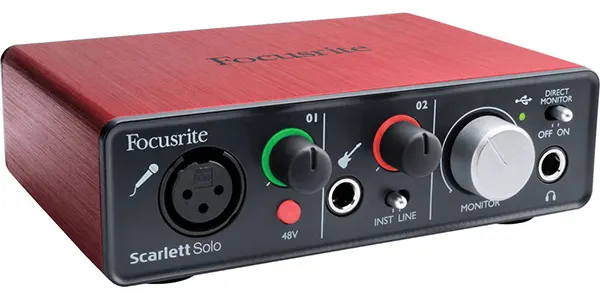
They also almost always come with an installation disc or download code for Digital Audio Workstation that allows you to record, mix, master, and bounce your final results with professional quality.
Yes, you will need to learn a few mixing tricks to remotely get professional results, no matter if you’re singing, rapping, playing piano, or doing voice-overs.
Heads Up: Dynamic microphones don’t need the 48 volts of Phantom Power you see in the picture above. That’s for condensers to power their tubes. In 99.9% of cases, you won’t harm a dynamic mic by running it with the Phantom Power on, but you should always take note to cut it off before plugging in or unplugging ANY mic. This is when damage can occur.
Recording & Mixing Tips
Check out these articles from this site, LedgerNote. Just open and bookmark them for later. You’ll need them. They guide you through the main mixing principles and tell you how to get it done easily.
- 14 Tips for Recording & Mixing Vocals – The Right Way…
- Recording Vocals at Home: Clean & Clear
- Fundamental Audio Mixing Tips & Technique
- Audio Mixing for Dummies
If you hit record, do your performance, and then wonder why your recording isn’t matching the industry releases you’re used to hearing, it’s not because of your mic. It’s because you need to do some mixing! Remember these words later if you’re new to the game!
And now we venture into…
